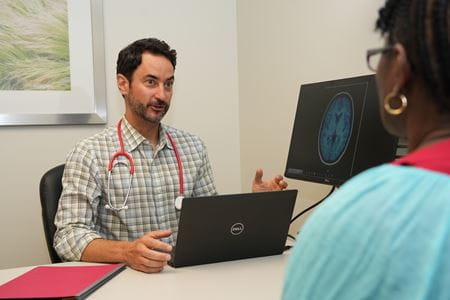A novel therapeutic target to treat Alzheimer’s disease identified in 2022 by Indiana University School of Medicine researchers will now be translated to a clinical trial, spearheaded through a collaboration between IU School of Medicine scientists and clinicians.
The trial, funded by an over $950,000 grant from the Alzheimer’s Association Part the Cloud grant program, will evaluate the treatment of niacin through a U.S. Food and Drug Administration-approved drug for patients who have mild to moderate symptoms of Alzheimer’s disease.
Gary Landreth, PhD, the Martin Professor of Alzheimer’s Research, and Miguel Moutinho, PhD, assistant research professor of anatomy, cell biology and physiology, led the scientific research in their lab at the Stark Neurosciences Research Institute at IU School of Medicine. Jared Brosch, MD, associate professor of clinical neurology at the school, will lead the clinical trial in the Department of Neurology.
The research team found that, in the brain, niacin — a B vitamin that’s mainly obtained through a typical diet but can also be taken in supplements and cholesterol-lowering drugs — interacts with a highly-selective receptor, HCAR2, that’s present in microglia associated with amyloid plaques. In the study, they found that after Alzheimer’s disease animal models received niacin, the HCAR2 receptor was activated and led to fewer plaques and improved cognition.
Moutinho and Landreth collaborated with Brosch to further the translational research of niacin and develop a clinical trial to test an FDA-approved formulation of niacin for Alzheimer’s disease patients.
 “This is a huge achievement for any basic research laboratory — to see their findings translated into the clinical setting with the expectation that patients can benefit from the work developed in the lab,” Moutinho said. “We are fortunate to work at Stark Neurosciences Research Institute and IU School of Medicine because they harness and promote translational research scientific discussions with clinicians.”
“This is a huge achievement for any basic research laboratory — to see their findings translated into the clinical setting with the expectation that patients can benefit from the work developed in the lab,” Moutinho said. “We are fortunate to work at Stark Neurosciences Research Institute and IU School of Medicine because they harness and promote translational research scientific discussions with clinicians.”
Brosch, who has administered more than 30 clinical trials over the last decade, said the niacin trial is targeted toward people with mild to moderate symptoms of Alzheimer's — a group that has historically had few treatment options other than drugs that have been around for 25 years.
“What excites me the most is that this trial represents the ideal path of discovery,” Brosch said. “Here at IU School of Medicine, we are unique in that we have the expertise, the active clinic of wonderful patients willing to volunteer and an experienced clinical trial team. This is why IU School of Medicine continues to lead the world in Alzheimer's research and drug development.”
IU School of Medicine is ranked No. 6 in funding from the National Institute on Aging (NIA), the largest branch for Alzheimer’s disease research within the National Institutes of Health (NIH). In 2024, the school received $87 million in grants to fund Alzheimer’s disease research.
Brosch said that without funding from Part the Cloud, the niacin trial may not have gotten off the ground. The grant program, which has invested $67.9 million in 68 trials to investigators across the country for more than a decade, provides an opportunity for early-stage clinical trials to be funded to broaden the understanding of Alzheimer’s disease and to hopefully generate new and innovative treatments.
As the IU School of Medicine-led clinical trial is still in its beginning stages, Moutinho said the lab is furthering their investigation into niacin and the effects of HCAR2 activation in tauopathy models, which mimic important aspects of Alzheimer's disease, and in other neurodegenerative conditions.
